Can schools be "separate but equal?"
The right to an education has long been a bedrock American assumption. However, while laws guarantee equal access to public schools in practice, the nation has not always achieved the ideal. The Northwest Ordinance of 1787, which was created to provide for the future of the nation’s western territories, set aside one square mile in each township (36 square miles in total) to support public schools. Very early in its frontier days, Iowa pioneers set up schools to educate their children.
Bedrock of Racial Discrimination in Iowa
Early Iowa laws tried to discourage African Americans from moving into the state and imposed penalties and restrictions on them. Because there were very few African-American families in the early population, racial integration in public schools was not a big issue and was handled on a local basis. As the slavery question became more contentious as the nation drifted toward the Civil War and free African Americans and runaway slaves began appearing more often, the future of race relations became more important. In Ringgold County along the Missouri border, African-American children whose family had fled slavery attended a one-room school. In Grinnell, however, a mob protested vigorously when the school was opened to African-American children, and a race riot followed.
Alexander Clark was a prominent African American in Muscatine. He was denied entry into the university law school because of his race, but he was determined to open opportunities for his children. In 1867, he filed a lawsuit when his daughter was not allowed to attend public school in Muscatine where a separate school had been set aside for African-American children. The Iowa Supreme Court ruled in his favor, declaring that schools could not bar children because of their race.
Prominent U.S. Supreme Court Cases
In 1896, the United States Supreme Court in Plessy v. Ferguson ruled that states could allow racial segregation as long as the facilities were “separate but equal.” In practice, however, facilities for African-American children were almost never equal but almost always inferior. In southern states, segregation was nearly universal and embedded in the law. In the north, including Iowa, local customs varied but in practice, African Americans were often barred from hotels and restaurants and often forced into separate facilities on trains, buses and sometimes schools. The few African Americans who attended public universities in Iowa were prohibited from living in school dormitories and were forced to find their own housing.
In 1954, the U.S. Supreme Court reversed its “separate but equal” position and declared in Brown v. the Board of Education that the segregation in public schools was unconstitutional and must end. This caused huge protests across the south. President Dwight Eisenhower had to call on federal troops to enforce school integration.
Legal but not Equal - Struggles of Desegregation
Legal segregation had ended, but true equality had not been achieved. Because African Americans and white people often lived in separate neighborhoods, their local schools continued to reflect the racial divide. In Massachusetts, the legislature required schools to achieve a racial balance in each school district by busing children to achieve proportionate numbers. In Boston through the 1970s and 80s, angry protests erupted from white parents who feared for the safety and educational quality of their children. Even today, because the races in many communities tend to separate themselves into different neighborhoods based on race, our schools are often heavily dominated by one racial group or another.
Taking steps to overcome past discrimination is called affirmative action. Many attempts to provide African Americans, other minorities, women, the physically and mentally impaired, and those with different sexual or gender orientations speak to the American commitment to equality of opportunity. The goal remains, however, a continuing challenge.
Supporting Questions
Is the U.S. Constitution color blind?
How did the “separate but equal” education start, and what did it look like?
- "Separate Coaches," Segregation of the Railroad, May 26, 1896 (Document)
- Classroom in the School, Siloam, Georgia, October 1941 (Image)
- The One-Teacher Negro School in Veazy, Georgia, October 1941 (Image)
How did the U.S. Supreme Court and Iowa Supreme Court end segregated education?
- Iowa Supreme Court Rules on Equal Access: Portrait of Alexander Clark, 1868 (Image & Document)
- Distribution of the Colored Population of the United States, 1898 (Map)
- Attorneys for Brown v. Board of Education, May 17, 1954 (Image)
- Distribution of Negro Population by County, 1956 (Map)
- "Segregation’s Citadel Unbreached in 4 Years," 1958 (Document)
Case Study: Who were the "Little Rock Nine" and why are they significant?
- Daisy Bates’ Letter about "Little Rock Nine," December 17, 1957 (Document)
- Anti-Integration in Little Rock, Arkansas, September 1958 (Image)
- Rally at State Capitol in Little Rock, Arkansas, August 20, 1959 (Image)
Case Study: How did Farmville, Virginia handle the issue of desegregation in schools?
- "Free School" in Farmville, Virginia, September 16, 1963 (Image)
- Obstructions and Delays: Griffin v. County Board of Prince Edward County Draft Ruling, January 6, 1964 (Document)
How did other people view and act on their view of school segregation?
- Six Years after Brown, Atlanta Citizens Discuss Their Schools, May 27, 1960 (Video)
- Governor George Wallace Attempting to Block Integration at the University of Alabama, June 11, 1963 (Image)
- President John F. Kennedy’s Civil Rights Address, June 11, 1963 (Video)
- "Dark laughter. Now I aint so sure I wanna get educated," September 21, 1963 (Image)
- Integration in D.C. Schools, December 15, 1964 (Image)
- African-American Children Encounter Protesters, September 13, 1965 (Image)
Instructional Note: After studying these sources topically, ask students to arrange them chronologically. How did one event shape the one after it? How do these images show progress over time?
| School Desegregation Source Set Teaching Guide |
| Printable Image and Document Guide |
Senator Thomas Martin’s Speech on Civil Rights, 1965
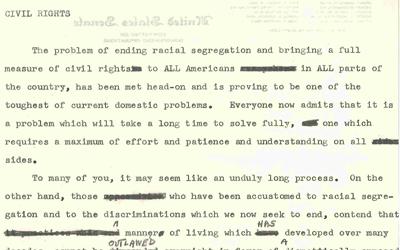
Description
U.S. Senator Thomas E. Martin explains the current work being done to desegregate schools and ensure equal rights for all races. He delivered these remarks in a speech made in 1965.
"Separate Coaches," Segregation of the Railroad, May 26, 1896
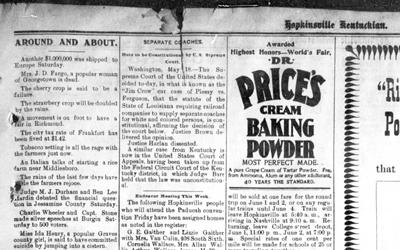
Description
In 1896, the U.S. Supreme Court established the idea of "separate but equal" in the case of Plessy v. Ferguson. This same U.S. Supreme Court also decided in 1896 that it was constitutional in Louisiana to require railroads to provide separate coach cars for people based on…
Classroom in the School, Siloam, Georgia, October 1941
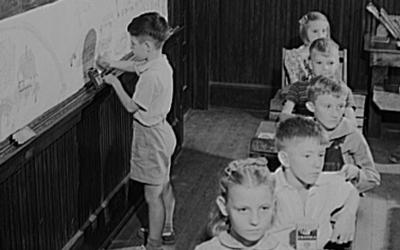
Description
Jack Delano, a photographer documenting life in the rural areas of the United States, took these two photographs, "The One-Teacher Negro School in Veazy" and "Classroom in the School." The photographs were taken in the same county in Georgia…
The One-Teacher Negro School in Veazy, Georgia, October 1941
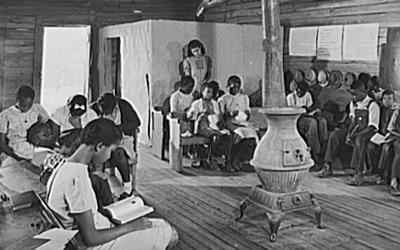
Description
Jack Delano, a photographer, took photos of two schools in the same county for the U.S. Food and Drug Administration in October 1941. The one featured was taken in a school designated for African-American children in Veazy, Georgia. The other photo,…
Iowa Supreme Court Rules on Equal Access: Portrait of Alexander Clark, 1868
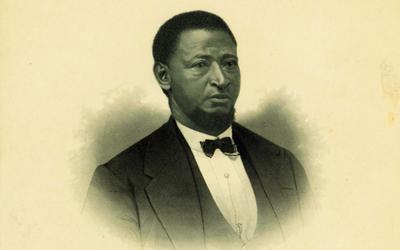
Description
On September 12, 1867, 12-year-old Susan Clark was denied admission to Muscatine's Second Ward Common School Number 2 because she was African American. Her father, Alexander Clark, a determined businessman of Muscatine, acted to resist racism and the segregation of Iowa’s…
Distribution of the Colored Population of the United States,1898
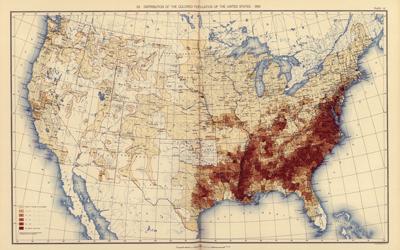
Description
A statistical atlas of the United States that is based on the results of the 11th census, completed in 1890, shows the distribution of the "colored population" of the country. As can be seen in the distribution map, members of the targeted population predominantly resided in…
Attorneys for Brown v. Board of Education, May 17, 1954
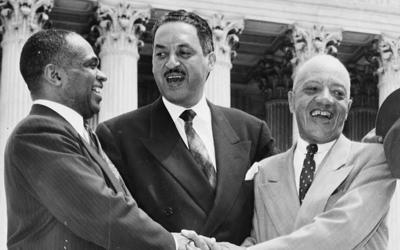
Description
The U.S. Supreme Court case, Brown v. Board of Education, was bundled with four related cases and a decision was rendered on May 17, 1954. Three lawyers, Thurgood Marshall (center), chief counsel for the NAACP’s Legal Defense Fund and lead attorney on the Briggs case,…
Distribution of Negro Population by County, 1956
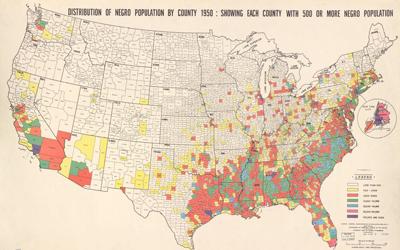
Description
A statistical atlas by Samuel Fitzsimmons shows the distribution of the "Negro population" by each county in 1950. The counties used in the map had an African-American population of 500 or more residents.
"Segregation’s Citadel Unbreached in 4 Years," May 11, 1958
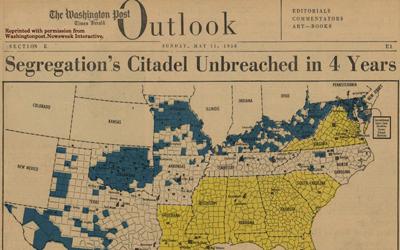
Description
The 1958 article from the Washington Observer observed the effects of the U.S. Supreme Court decision for Brown v. Board of Education. At the time of the May 1954 ruling, 17 states and Washington, D.C., had laws enforcing school segregation. By 1958, only seven…
Daisy Bates’ Letter about "Little Rock Nine," December 17, 1957
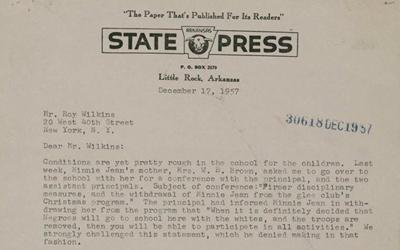
Description
Daisy Bates, civil rights activist, journalist and lecturer, wrote a letter on December 17, 1957, to then-NAACP Executive Secretary Roy Wilkins. The letter focused on the treatment of the nine African-American children, known as the "Little Rock Nine" at Central High School…
Anti-Integration in Little Rock, Arkansas, September 1958
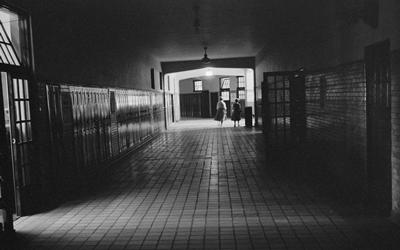
Description
Even after the U.S. Supreme Court ruling that segregation in public schools was unconstitutional, some states were adamantly against the integration of schools. This photograph shows an almost-empty hallway at Central High School in Little Rock, Arkansas, in September of…
Rally at State Capitol in Little Rock, Arkansas, August 20, 1959
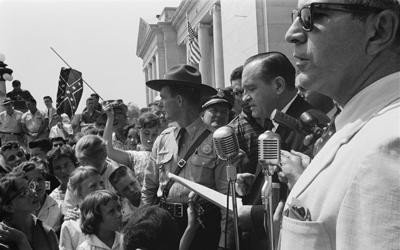
Description
As the "Little Rock Nine," a group of nine African-American students, enrolled in Little Rock Central High School in 1957, their enrollment was followed by angry gatherings of individuals who wanted to prevent the students from entering the racially-segregated school. This…
“Free School” in Farmville, Virginia, September 16, 1963
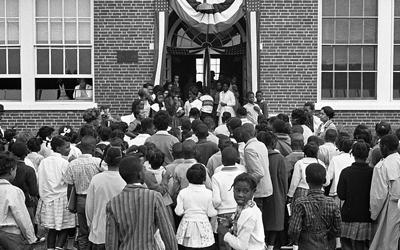
Description
Prince Edward County, Virginia, closed all of its schools in 1959 rather than integrate in accordance with the U.S. Supreme Court's decision that segregation of public schools was unconstitutional. The white citizens in the county formed a private all-white academy…
Obstructions and Delays: Griffin v. County Board of Prince Edward County Draft Ruling, January 6, 1964
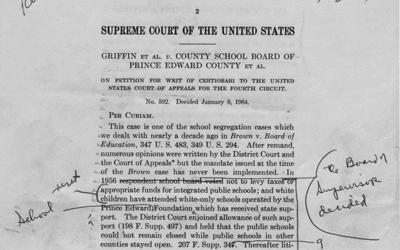
Description
The diehard segregationist campaign of "massive resistance" took many forms. In Virginia's Prince Edward County, location of one of the original school-segregation cases, local authorities evaded court-ordered integration by closing the public schools and supporting new,…
Six Years after Brown, Atlanta Citizens Discuss Their Schools, May 27, 1960

Description
In response to the Brown v. Board decision, Georgia passed legislation requiring the closing of public schools that had been forced to integrate by court orders and their conversion to private schools. After a federal judge ordered the Atlanta School Board to submit a…
Governor George Wallace Attempting to Block Integration at the University of Alabama, June 11, 1963
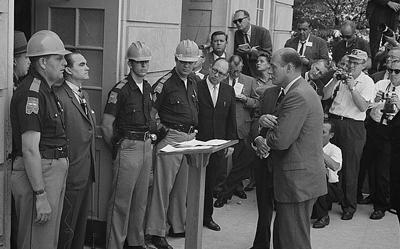
Description
Known as the "Stand in the Schoolhouse Door," Alabama Governor George Wallace stood in front of Foster Auditorium at the University of Alabama on June 11, 1963, to stop the enrollment of African-American students Vivan Malone and James Hood. He was being confronted by Deputy…
President John F. Kennedy’s Civil Rights Address, June 11, 1963

Description
The excerpt highlights President John F. Kennedy's broadcasted speech announcing he would soon ask the U.S. Congress to enact landmark civil rights legislation. The speech and the legislation was in part a reaction to the actions of Alabama Gov. George Wallace, who attempted…
"Dark laughter. Now I aint so sure I wanna get educated," September 21, 1963
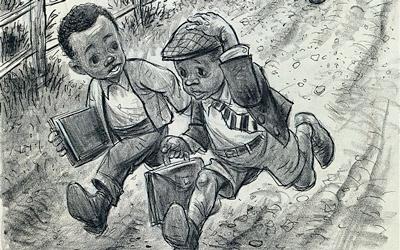
Description
Political cartoonist Oliver Harrington published this cartoon in 1963 that depicts two African-American boys dressed for school who are running from a crowd of angry people. Harrington created the piece as a form of social commentary on the protests occurring of individuals…
Integration in D.C. Schools, December 15, 1964
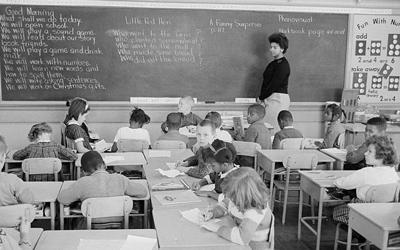
Description
After the Brown v. Board of Education decision by the U.S. Supreme Court, integration of public school classrooms was still a work in progress. This photo, taken 10 years after the U.S. Supreme Court ruling, showed a class in Washington, D.C., in 1964 that has both African-…
African-American Children Encounter Protesters, September 13, 1965
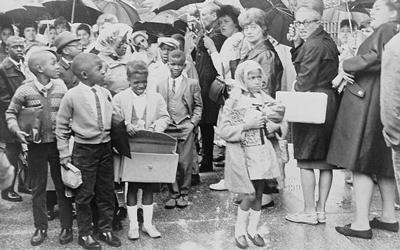
Description
Even as the integration of public schools in the United States increased, some Americans fought to keep schools segregated. Pictured are African-American children in New York on their way to Public School 204. As they attempt to enter school, the children have to pass…
Additional Resources:
- Supreme Court Cases
- Plessy v. Ferguson, U.S. Supreme Court, 1896
A landmark constitutional law case that upheld the state racial segregation laws for public facilities under the doctrine of "separate but equal." - Brown v Board of Education Case Image
The image is of Mrs. Nettie Hunt, sitting on steps of U.S. Supreme Court, holding a newspaper, explaining to her daughter Nikie the meaning of the Supreme Court's decision banning school segregation in 1954. - Parents Involved in Community Schools v. Seattle School District No. 1
In a U.S. Supreme Court ruling from 2006, the Court applied a "strict scrutiny" framework and found a school district's racial tiebreaker plan was unconstitutional under the Equal Protection Clause of the Fourteenth Amendment.
- Plessy v. Ferguson, U.S. Supreme Court, 1896
- Ruby Bridges
- Through My Eyes by Ruby Bridges
Ruby Bridges was the first African-American child to desegregate the all-white William Frantz Elementary School in Louisiana during the New Orleans school desegregation crisis in 1960. The book is a firsthand account of Bridges' experience as a six-year-old girl being thrust into the spotlight as an iconic figure in the civil rights movement. - Portrait of Ruby Bridges
A 1960 portrait of six-year-old Ruby Bridges. - Collection of images of Ruby Bridges going to school, New Orleans Times-Picayune
Powerful images of Ruby Bridges on her first day at William Frantz Elementary School in 1960, as she was escorted into the school by U.S. marshals for protection. - Ruby Bridges Remembers
The video interview with Ruby Bridges was for the 50th Anniversary of Brown v. Board of Education in 2010.
- Through My Eyes by Ruby Bridges
- NYT Newspaper Articles
- "Mississippi Plans Equalized Schools," The New York Times, November 4, 1953
- "Mississippi Backs Separate Schools," The New York Times, December 22, 1954
- "Segregation Aid Seen," The New York Times, October 31, 1951
- African-American Students Entering Central High School
A group of African-American students in Little Rock, Arkansas, known as the "Little Rock Nine," are being escorted into a desegregated school by troops in 1957.
Iowa Core Social Studies Standards (5th Grade)
Listed below are the Iowa Core Social Studies content anchor standards that are best reflected in this source set. The content standards applied to this set are elementery-age level and encompass the key disciplines that make up social studies for fifth grade students.
| No. | Standard Description |
| SS.5.9. | Analyze the strategies that a variety of demographic groups have used to ensure their rights. |
| SS.5.11. | Explain the processes people use to change rules and laws in the classroom, school, government, and/or society. (21st century skills) |
| SS.5.19. | Create geographic representations to illustrate how cultural and environmental characteristics of a region impacted a historical event. |
| SS.5.20. | Analyze how rules and laws encourage or restrict human population movements to and within the United States of America. |